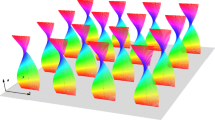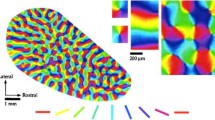Abstract
The aim of this work is to investigate the effect of the shift-twist symmetry on pattern formation processes in the visual cortex. First, we describe a generic set of Riemannian metrics of the feature space of orientation preference that obeys properties of the shift-twist, translation, and reflection symmetries. Second, these metrics are embedded in a modified Swift–Hohenberg model. As a result we get a pattern formation process that resembles the pattern formation process in the visual cortex. We focus on the final stable patterns that are regular and periodic. In a third step we analyze the influences on pattern formation using weakly nonlinear theory and mode analysis. We compare the results of the present approach with earlier models.
Similar content being viewed by others
Abbreviations
- G(x, y, v):
-
Elongated Gaussian distribution
- \({\hat{R}(\Phi), \hat{T}(\Psi)}\) :
-
2 × 2 rotation matrices
- \({d_{s}^{2}}\) :
-
Distance between stimuli, between receptive fields and stimuli
- x, y, z1, z2:
-
Real-valued features
- x, z :
-
Complex features
- v :
-
Feature vector
- \({\mathcal{V}}\) :
-
Feature space – manifold
- \({\hat{g}, g_{ij}}\) :
-
Metric tensor
- a, b, c, h:
-
Parameter functions of the metric tensor
- β, γ, μ, ν :
-
Parameter functions in complex coordinates
References
Cross MC, Hohenberg PC (1993) Pattern formation outside equilibrium. Rev Mod Phys 65(3): 851–1112
Durbin R, Willshaw D (1987) An analogue approach to the traveling salesman problem using an elsatic net algorithm. Nature 326: 689–691
Ernst U, Pawelzik K, Sahar-Pikielny C, Tsodyks M (2001) Intracortical origin of visual maps. Nat Neurosci 4: 431–436
Freeman RD, et al (1997) Clustering of response properties of neurons in the visual cortex. In: Social Neuroscience, 23:227.1
Jones J, Palmer L (1987) The two-dimensional spatial structure of simple receptive fields in cat striate cortex. J Neurophys 58: 1187–1211
Kaschube M, Wolf F, Geisel T, Loewel S (2001) The prevalance of colinear contours in the real world. Neurocomputing 38(40): 1335–1339
Kohonen T (2001) Self-organizing maps. Springer, Heidelberg
Liu Z, Gaska JP, Jacobson LD, Pollen DA (1991) Interneural interaction between members od quadrature pairs in the cat’s visual cortex. Vision Res 32: 1193–1198
Löwel S (1998) The layout of orientation and ocular dominance domains in area 17 of strabismic cats. Eur J Neurosci 10(8): 2629–43
Mayer NM, Herrmann MJ, Theo Geisel (1998) A cortical interpretation of ASSOMs. In: Proceedings of International Conference on Artificial Neural Networks (ICANN), vol 2, pp 961–966
Mayer NM, Herrmann JM, Geisel T (2002) Curved feature metrices in models of visual cortex. Neurocomputing 44–46(C): 533–539
Mayer NM, Herrmann JM, Geisel T (2003) Shaping of receptive fields in visual cortex during retinal maturation. J Comp Neurosci 15(3): 307–320
Pollen D, Ronner S (1981) Phase relationships betweeen adjacent simple cells in the visual cortex. Science 212: 1409–1411
Riesenhuber M, Bauer H-U, Brockmann D, Geisel T (1998) Breaking rotational symmetry in a self-organizing map model for orientation map development. Neural Comput 10: 717–730
Ritter H (1999) Self-organizing maps in non-Euclidean spaces. In: Oja E, Kaski S (eds) Kohonen Maps, pp 97–108
Ritter H, Martinetz T, Schulten K (1992) Neuronale netze. Addison Wesley, Bonn
Sengpiel F, Bonhoeffer T, Stawinski P (1999) Influence of experience on orientation maps in cat visual cortex. Nat Neurosci 2: 727–732
Swindale NV (1996) The development of topography in the visual cortex: a review of models. Network 7: 161–247
Swindale NV, Shoham D, Grinvald A, Bonhoeffer T, Hübener M (2000) Optimizing coverage in the cortex. Nat Neurosci 3(8): 750–751
Thomas PJ, Cowan JD (2003) Symmetry induced coupling of cortical feature maps. Phys Rev Lett 92(18810)
Malsburg Cvd (1973) Self-organization of orientation sensitive cells in striate cortex. Kybernetik 14: 49–54
Wolf F (2005) Symmetry, multistability, and long-range interactions in brain development. Phys Rev Lett 95(208701)
Wolf F, Geisel T (1998) Spontaneous pinwheel annihilation during visual development. Nature 395: 73–78
Wolf F, Geisel T (2003) Universality in visual cortical pattern formation. J Phys 97: 253–264
Author information
Authors and Affiliations
Corresponding author
Rights and permissions
About this article
Cite this article
Michael Mayer, N., Browne, M., Herrmann, J.M. et al. Symmetries, non-Euclidean metrics, and patterns in a Swift–Hohenberg model of the visual cortex. Biol Cybern 99, 63–78 (2008). https://doi.org/10.1007/s00422-008-0238-9
Received:
Accepted:
Published:
Issue Date:
DOI: https://doi.org/10.1007/s00422-008-0238-9




